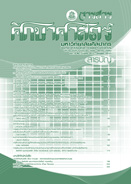การจัดการความรู้ของเกษตรกรในภาคตะวันออกเฉียงเหนือ
Main Article Content
บทคัดย่อ
1. สภาพการจัดการความรู้ของกลุ่มเกษตรกร ได้แก่ 1) การแสวงหาความรู้ กลุ่มเกษตรกรทำนา แสวงหาความรู้ที่เป็นภูมิปัญญาพื้นบ้านจากพ่อแม่ ปู่ย่า ตายาย แสวงหาความรู้สมัยใหม่จากหัวหน้ากลุ่ม หมอดินหมอข้าว สมาชิกกลุ่ม สื่อต่างๆ หน่วยงานส่งเสริมการเกษตรของรัฐในท้องถิ่น เกษตรกรที่ประสบผลสำเร็จส่วนกลุ่มเกษตรกรทำสวนยางพาราแสวงหาความรู้จากหัวหน้ากลุ่มครูยาง สมาชิกกลุ่มตลาดจำหน่ายยางประจำกลุ่มสวนยางพารา สำนักงานกองทุนสงเคราะห์การทำสวนยางประจำท้องถิ่น ตลาดกลางจำหน่ายยางพารา สื่อต่างๆ วิธ๊การเรียนรู้ ได้แก่ การเลียนแบบ การซึมซับ การสอน การสาธิต การสอบถาม การฝึกอบรม การศึกษาดูงาน การประชุมการพบปะพูดคุย 2) การจัดเก็บความรู้ เกษตรกรส่วนใหญ่จัดเก็บความรู้แบบการจดจำมากกว่าการจดบันทึก เนื่องจากเป็นวิธีที่ง่ายและสามารถนำความรู้ออกมาใช้ได้ทันที 3) การสร้างความรู้ เกษตรใช้ประสบการณ์ ความรู้เดิม และการสังเกตเป็นฐานคิด เพื่อสร้างความรู้ใหม่ด้วยการทดลองปฏิบัติ การลองผิดลองถูก 4) การประเมินความรู้ เกษตรกรมีการประเมินก่อนและหลังการใช้ความรู้ 5) การใช้ความรู้ คือ การใช้ภูมิปัญญาพื้นบ้าน การใช้ความรู้สมัยใหม่ และการประยุกต์ใช้ภูมิปัญญาพื้นบ้านผสมผสานกับความรู้สมัยใหม่ 6) การแลกเปลี่ยนความรู้ มี 4 รูปแบบ คือ การแลกเปลี่ยนความรู้ระดับครอบครัว ระดับกลุ่ม ระดับชุมชน และระดับเครือข่าย วิธีการแลกเปลี่ยนความรู้ คือ การสอน การสาธิต การบอกเล่า การพบปะพูดคุย การประชุม การฝึกอบรม และการศึกษาดูงาน
2. แนวทางส่งเสริมการจัดการความรู้ คือ 1) การแสวงหาความรู้ เกษตรกรควรกำหนดความต้องการความรู้ วิธีการเรียนรู้ การส่งเสริมให้มีทั้งแหล่งภูมิปัญญาพื้นบ้านและแหล่งความรู้สมัยใหม่ 2) การจัดเก็บความรู้ควรมีสถานที่จัดเก็บเอกสาร จัดทำระบบการจัดเก็บ ผู้รับผิดชอบในการจัดเก็บ 3) การสร้างความรู้ ได้แก่ การรื้อฟื้นภูมิปัญญาพื้นบ้าน การเลียนแบบ การสร้างความรู้ใหม่โดยการทดลองด้วยตัวเอง กลุ่ม และเครือข่าย 4) การประเมินความรู้ เกษตรกรควรประเมินก่อนการใช้ความรู้ ระหว่างการใช้ความรู้ และหลังการใช้ความรู้ 5) การใช้ความรู้ ได้แก่ การใช้ความรู้ตามคำแนะนำของเจ้าหน้าที่ส่งเสริมการเกษตร การใช้ภูมิปัญญาพื้นบ้าน และควรประยุกต์ใช้ภูมิปัญญาพื้นบ้านผสมผสานกับความรู้สมัยใหม่ และสร้างข้อสรุป 6) การแลกเปลี่ยนความรู้ ระดับครอบครัวควรให้สมาชิกครอบครัวมีโอกาสเข้ารับการฝึกอบรมตามความถนัด ความสนใจ และนำมาบอกเล่าคนในครอบครัวส่วนระดับกลุ่ม ระดับชุมชน และระดับเครือข่าย ควรมีการประชุมแลกเปลี่ยนเรียนรู้อย่างสม่ำเสมอ
Knowledge Management of Agriculturists in the Northeasern Region
The purposes of this research were to study the state of knowledge management and the guidelines development for promoting the knowledge management of agriculturists in the northeastern region of Thailand. Qualitative research was applied in this research. The study of the state of knowledge management used focus group and in-depth interview with two agriculturist groups of rice cultivation farmers, two agriculturist groups of rubber planters, and two best practice case studies. The guidelines development for promoting the knowledge management used in-depth interview with six scholars and four agriculturists. The research instruments were the focus groups issue and the structure interview. Data were analyzed by using content analysis. The results revealed that;
1. The state of knowledge management of the agriculturist groups included 1) Knowledge acquisition. Rice cultivation farmers were seeking the local wisdom from their parents and grandparents, and seeking modern knowledge from group leader, group members, soil specialists, government agencies of agricultural extension, best practices, and media. Rubber planters were seeking knowledge from group leader, group members, rubber plantation specialists, rubber fields, rubber markets, and Office of the Rubber Replanting Aid Fund. The learning approaches were emulating, absorption, query, teaching, demonstrating,training, field trip, and meeting. 2) Knowledge storage. Most of the agriculturistgroups stored knowledge by memorizing more than recording. Because it was the easy way and knowledge could be used immediately.3) Knowledge creation. The agriculturist groups used former experience, indigenou sknowledge, and observation to create new knowledge and to confirm by practicing, and trial and error. 4) Knowledge evaluation. The agriculturist groups were evaluating knowledge both before and after knowledge usage. 5) Knowledge usage. The agriculturist groups were using local wisdom, modern knowledge, and integrated local wisdom with modern knowledge. 6) Knowledge sharing. The agriculturist groups were sharing knowledge in family level, within group level, community level, and the group networks.
2. The guidelines development for promoting the knowledge management of the agriculturist groups included1) Knowledge acquisition,they should determine the knowledge and methods to learn, and should promote the local wisdom and modern knowledge resources. 2) Knowledge storage. The tacit knowledges torage with the lesson learned should be recorded in media. The explicit knowledge should be stored, classified and assigned systematically. 3) Knowledge creation included revival of local wisdom, emulating, and new knowledge creation through action with self-trial, group, and network. 4) Knowledge evaluation should be evaluated pre knowledge usage, between knowledge usage, and post knowledge usage. 5) Knowledge usage should be used under the advice of agricultural extension officers, local wisdom usage, and application of local wisdom with modern knowledge. 6) Knowledge sharing included knowledge sharing at family level with shared responsibilities among family members and providing the opportunity to attend training according to their aptitude and brought back to tell other members; at group and community levels, the network should arrange the meeting and sharing knowledge regularly.

